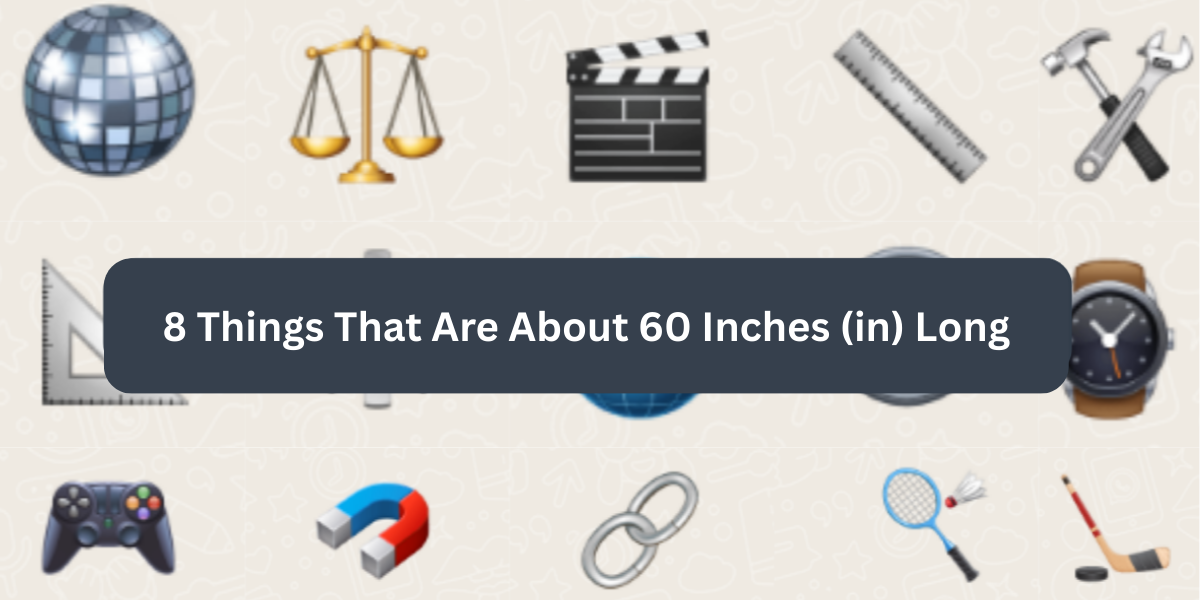Sixty inches might look small on paper, but in real life it’s a very handy reference: 60 in = 5 feet = 152.4 cm (1.524 m). Whether you’re shopping for furniture, planning a bathroom remodel, or trying to picture a piece of gear, visual comparisons make measurements sticky and useful.
This article walks through 8 common things that are about 60 inches long, explains why that length matters, and gives practical tips for buying and fitting these items into your space. Use this as a ready reference when you need to picture things that are 60 inches long without grabbing a tape measure.
Quick conversions (so you don’t have to)
- 60 inches = 5 feet (5′0″)
- 60 inches = 152.4 centimeters
- 60 inches = 1.524 meters
Keep these conversions in mind when comparing U.S. and metric product specs.
8 common things that are about 60 inches long
1) Standard alcove bathtub
Why it’s relevant: The classic alcove bathtub sold for decades in the U.S. is typically 60 inches long and about 30–32 in wide. That standardization matters when you remodel bathrooms or replace a tub without reworking plumbing.
Practical tips:
- If you’re replacing a tub, confirm rough opening and drain placement; many replacement tubs assume the 60 in footprint.
- For small baths, a 60-in tub often fits nicely while still leaving room for a vanity and toilet.
2) 60-inch TV (diagonal)
Why it’s relevant: A 60-inch TV is a very common screen size for living rooms. The advertised 60 inches is the diagonal measurement. For a 16:9 TV the approximate screen dimensions are: Width ≈ 52.3 in, Height ≈ 29.4 in.
Viewing distance guide: For a 4K TV, a good sweet spot is about 1–1.5× diagonal (5–7.5 feet) from the screen. For 1080p, sit farther back.
Mounting tips: Check VESA pattern and wall stud placement; 60-inch sets can be heavy and wide. Also confirm the TV’s box size to make sure it fits through doors and stairwells.
3) 60-inch round dining table
Why it’s relevant: A 60-inch round table (5 ft diameter) is a popular dining size that comfortably seats 6 and can squeeze 8 for gatherings. Round tables are space-friendly in many layouts and encourage conversation.
Spacing rules: Allow roughly 36–48 inches from the table edge to walls/chairs for comfortable movement. For seating, plan 20–24 inches of width per person around the table.
4) 5×8 area rug (5 ft = 60 in)
Why it’s relevant: One of the most common rug widths is 5 feet (60 inches) — think a 5×8 ft rug (60 × 96 in). That size fits well under a small dining table, in front of a sofa, or in bedrooms where a larger rug would overwhelm the room.
Style tip: Position the rug so furniture legs either sit fully on it or front legs sit on the rug for a cohesive look. Leave at least 18–24 inches of bare flooring around the rug in living spaces for balance.
5) Snowboard ~152 cm (≈60 in)
Why it’s relevant: Many adult snowboards are sold in lengths around 150–156 cm (≈59–61 in). A 152 cm board is essentially a 60-inch board and is a common all-mountain length for medium-weight riders.
How to choose: Board length depends on rider weight, style, and skill. A 152 cm board suits many intermediate riders in a typical weight range; beginners often choose slightly longer for stability. Always check manufacturer sizing charts.
6) 5-foot (60-in) entry / park bench
Why it’s relevant: Benches used in parks, entryways, or at the foot of a bed are commonly made in 48–60 inch lengths. A 5-foot bench is roomy enough for two to three people and fits many entryway nooks and porches.
Buying tip: For outdoor benches, pick weather-resistant materials (cedar, treated lumber, metal). For indoor benches, account for cushion thickness when matching to other furniture heights.
7) 5-foot (60-in) fence panel
Why it’s relevant: While many privacy fences are 6 ft (72 in), 5-foot fence panels are also common for lower privacy or decorative fences around gardens and small yards. A 60-inch panel provides privacy without blocking light as much as taller options.
Installation note: Confirm whether the 60-inch measure is nominal (panel only) or includes posts; also check local rules for maximum fence heights.
8) A 5-foot tall person
Why it’s relevant: The simplest mental image for 60 inches is a person 5 feet tall. This visual helps you immediately understand many household item sizes and compare how furniture will relate to body-scale.
Use case: If you’re buying a mirror, wardrobe, or wall art, imagining a 5-ft person next to the object helps gauge proportion.
Space-planning checklist for items ~60 inches
- Measure twice: doorways, hallways, stairwells, and elevator clearances.
- Account for packaging: many products ship in larger boxes than their final dimensions.
- Leave working space: allow a few extra inches for moving and angling bulky items into position.
- Clearance & circulation: allow 36 in minimum for walkways around tables and furniture.
- Weight & mounting: check load ratings (TV mounts, wall mirrors, etc.) and use proper anchors/studs.
Quick FAQ — 60 inches in common questions
Q: How many feet is 60 inches?
A: 5 feet.
Q: How many centimeters is 60 inches?
A: 152.4 cm.
Q: Is a 60-inch TV 5 feet wide?
A: No — 60 inches is the diagonal. A 60-inch 16:9 TV is about 52.3 inches wide and 29.4 inches tall.
Q: Will a 60-inch sofa fit through my doorway?
A: Possibly — you need at least 60 in of clearance in the direction you’re moving it, plus space to angle if the doorway is narrower. Always measure your route.
Conclusion
If you need a quick mental ruler, remember 60 inches = 5 feet = 152.4 cm and that it shows up in everyday objects: the standard alcove bathtub, many 60-inch TVs, 60-inch round tables, 5×8 rugs (60 in wide), common snowboard lengths, 5-foot benches, 5-foot fence panels, and the height of a 5-ft person. Those comparisons make it easy to visualize scale and avoid sizing mistakes when shopping or planning a room.
Want this formatted as a printable one-page infographic or a ready-to-paste FAQ block for your site? I can create that next — tell me which visuals you want included and I’ll generate a clean, mobile-friendly layout.

